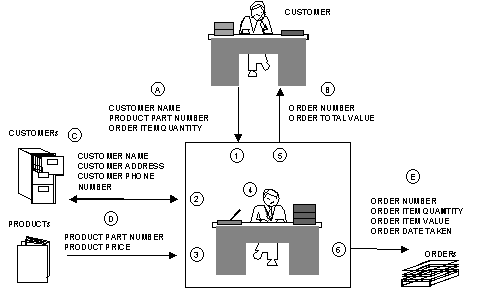

A view is a window through which a process can communicate information about entities. There are four types of information views:
For example, imagine the manual Take Order process that is depicted in the following illustration.

The large box around the clerk in the illustration represents the boundaries of the elementary Take Order process.
Refer to the following table for an explanation of the key activities in this process.
|
Key |
Activity |
|---|---|
|
1 |
Customers contact the store and provide the clerk with their Name, a list of products, and the Quantity of each product they wish to order. |
|
2 |
The clerk walks to a filing cabinet containing records for all customers with which the store deals, and checks to make certain that the customer is on file. If the customer is not on file, the order cannot be taken until certain information about the customer is recorded in the file. |
|
3 |
For each product requested, the clerk looks up its price in the product book and records it on the appropriate order item. The clerk also calculates the value of the order item by multiplying the product Price by the Quantity Ordered. |
|
4 |
The clerk sums the Value of each order item to determine the Total Value of the order. |
|
5 |
The clerk then contacts the customer and tells them the order Number and the Total Value of the order. |
|
6 |
The clerk types up an order for all the items the customer wishes to purchase, and places it in a basket containing open orders. Assume that the order Number is a pre-printed unique number on the order form. |
Customer is an external object. It is a real entity that both provide information to and receives information from Take Order. However, it is "external" to the stored information about the business.
Take Order deals with four entity types:
The Take Order process has two views of customer:
Both are views of the same customer entity; they are simply used for different purposes.
The Take Order process relates to entities in three ways:
Another type of view, named a local view, is not used by Take Order. The local views are used infrequently during analysis because they usually represent temporary information that is used within a process.
|
Copyright © 2014 CA.
All rights reserved.
|
|